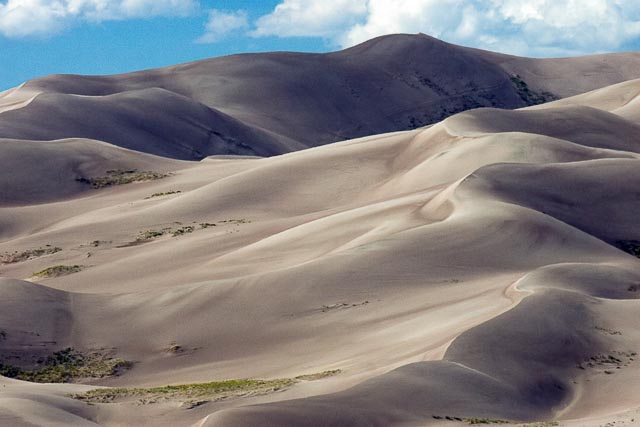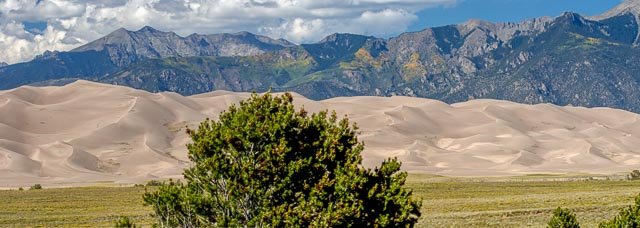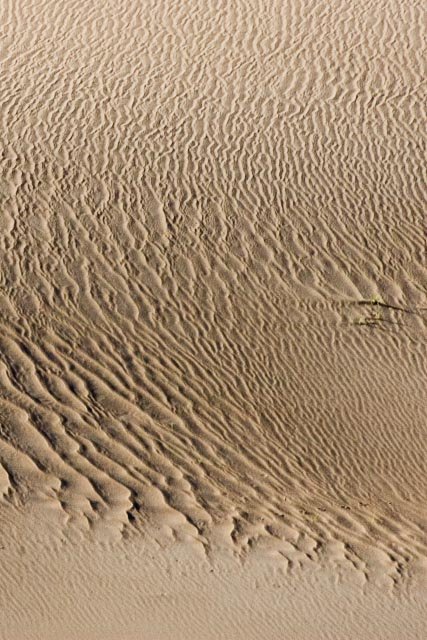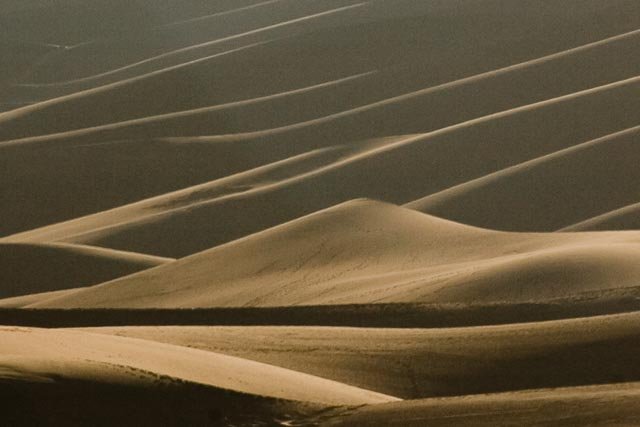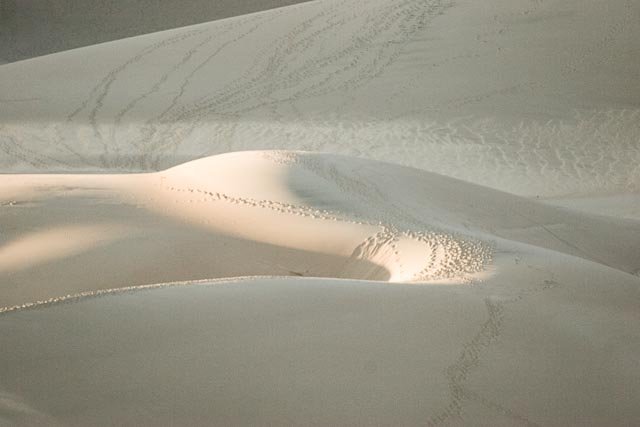Great Sand Dunes National Park

Great Sand Dunes National Park and Preserve conserves an area of large sand dunes and an adjacent national preserve in the Sangre de Cristo Range, in south-central Colorado, United States. The park contains the tallest sand dunes in North America, up to 750 feet tall on the eastern edge of the San Luis Valley. The dunes cover an area of about 30 sq mi and are estimated to contain over 1.2 cubic miles of sand.
Sediments from the surrounding mountains filled the valley over geologic time periods. After lakes within the valley receded, exposed sand was blown by the predominant southwest winds toward the Sangre de Cristos, eventually forming the dunefield over an estimated tens of thousands of years. Ecosystems within the mountain watershed include alpine tundra, subalpine forests, montane woodlands, and riparian zones.
Evidence of human habitation in the San Luis Valley dates back about 11,000 years. The first historic peoples to inhabit the area were the Southern Ute Tribe; Apaches and Navajo also have cultural connections in the area. In the late 17th century, Diego de Vargas, a Spanish governor of Santa Fe de Nuevo México, became the first European on record to enter the San Luis Valley. Juan Bautista de Anza, Zebulon Pike, John C. Frémont, and John Gunnison all travelled through and explored parts of the region in the 18th and 19th centuries. The explorers were soon followed by settlers who ranched, farmed and mined in the valley starting in the late 19th century. The park was first established as a national monument in 1932 to protect it from gold mining and the potential of a concrete manufacturing business.
Visitors must walk across the wide and shallow Medano Creek to reach the dunes in spring and summer. The creek typically has a peak flow from late May to early June. From July to April, it is usually no more than a few inches deep, if there is any water at all. Hiking is permitted throughout the dunes with the warning that the sand surface temperature may reach 150 °F in summer. Sandboarding and sandsledding are popular activities, both done on specially designed equipment that can be rented just outside the park entrance or in Alamosa. Visitors with street-legal four-wheel drive vehicles may continue past the end of the park’s main road to Medano Pass on 22 miles of unpaved road, crossing the stream bed of Medano Creek nine times and traversing 4 miles of deep sand. Hunting is permitted in the preserve in the autumn, but prohibited within national park boundaries at all times. The preserve encompasses nearly all of the mountainous areas north and east of the dunefield, up to the ridgeline of the Sangre de Cristos.
Where it is:
To access the main park area, including the Dunes Parking Lot, Visitor Center, and Pinyon Flats Campground, take Highway 150 from the south or County Road 6 from the west. Both are paved highways.
From Denver, Colorado Springs, or Pueblo, the most common route is south on I-25 to Walsenburg, west on US 160, north on State Highway 150. For a more mountainous drive from Denver (same mileage as the I-25 route), you may also take US 285 south, then State Highway 17 south, then County Lane 6 east from Mosca.
From Albuquerque, drive north on I-25 to Santa Fe, then north on US 285 to Alamosa. From Alamosa, take either U.S. Highway 160 east and State Highway 150 north, or State Highway 17 north and County Lane 6 east from Mosca.
Maps:
Interactive Google Map
Use the map + – controls to zoom in and out, click and drag the to move the map, use the Map drop-down to change to “Map”, “Satellite”, “Hybrid”, or “Terrain” views. Drag the little man icon from the upper left corner to a map location for street level view.
GPS:
37°44’5.2304″ N 105°30’29.0459″ W
Cost:
Entrance Fees
Visitors will be charged only one of the following fees. Fees are charged only when the entrance station is open in the spring, summer, and fall seasons or when the visitor center is open in the winter season.
Basic Entrance Pass
(good for up-to seven consecutive days)
- Non-Commercial Vehicle and Occupants (normal car): $25
- Oversized Vehicle, 15+ passengers, age 16+ (large van): $15/person
- Motorcycle and Riders: $20
All National Park Access passes are accepted
Hours:
Great Sand Dunes National Park Photo Gallery
Click Here for full page gallery
More Photographic Destinations in Colorado
Interactive Google Map
Use the map + – controls to zoom in and out, use the Map drop-down to change to “Map”, “Satellite”, “Hybrid”, or “Terrain” views. Drag the little man icon from the upper left corner to a map location for street level view. Click on a pushpin for more information about the Photographic Destination, then click on the title to go to the location page.
Click Here for Photographic Destinations by State

